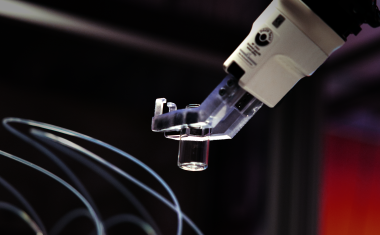Poised For Growth




Chemistry: it’s in everything and it’s everywhere. In fact, nearly all manufactured goods are directly touched by chemistry, either as a material, in processing, or in some other value-added means. The US is a global leader in chemical production, providing over 15% of the world’s chemicals and representing 14% of all US exports. It is also one of the US’s largest manufacturing industries, an $801 billion enterprise providing 804,000 high-paying jobs.
Essential to our everyday lives, the business of chemistry is a $5.4 trillion global industry. Innovations in chemistry have contributed to countless economic and social benefits: longer and healthier lives through medical advancements, improved standards of living from fertilizers and water treatment, and instant access to information from anywhere thanks to smartphones (and other “smart” devices), just to name a few. Over 96% of all manufactured goods – from permanent-press clothing to protective packaging materials to strong and light composite materials in aircraft — are directly touched by chemistry.
In 2014, the US produced 1.2 billion t of these essential chemicals and chemical products, valued at $801 billion (the value of the US chemical business is measured along the lines of the value of its shipments, as reported by the US Bureau of the Census). Generally speaking, the composition of chemical shipments by segment in the US mirrored global activity. Basic (or commodity) chemicals made up $334 billion (42%) in shipments; of those, more than half were bulk petrochemicals and intermediates, followed by plastic resins, and inorganic chemicals. The second largest segment was pharmaceuticals, including prescription and over-the-counter drugs and other pharmaceutical preparations for both human and veterinary use, with $178 billion (22%). Specialty (or performance) chemicals, like adhesives and sealants, catalysts, coatings, electronic chemicals, and plastic additives, accounted for $150 billion (19%), followed by consumer products ($91 billion, 11%) and agricultural chemicals ($46 billion, 6%).
Chemicals (and chemical products) are produced in nearly every US state; however, most production of basic chemicals is concentrated in the Gulf Coast region, where petroleum and natural gas raw materials are more readily available than in other parts of the country. In fact, about 70% of all primary petrochemicals are produced in Texas and Louisiana. The business of converting these basic chemicals into plastics, synthetic fibers, rubber, and other chemical products is not as heavily concentrated on the Gulf Coast and tends to be more diffused. For example, the majority of synthetic fiber production occurs in the Southeast, while production of other chemical products is more widely dispersed among the states.
Although chemical production is relatively concentrated, geographically speaking, the industry’s economic impact is not just about geography. Not only does it support nearly 25% of the US GDP, the chemical industry directly employs over 800,000 people in roles such as equipment operators, engineers, sales managers, scientists, and environmental protection professionals. An additional 2.6 million jobs are supported by the suppliers to the chemical industry, jobs such as equipment manufacturers, wholesalers, contractors, construction workers, and transportation operators. Moreover, another 2.5 million jobs are supported through the indirect purchases of the industry’s suppliers and its employees. For every direct job created by the chemical industry, more than six additional jobs are generated elsewhere in the economy, totaling nearly 6 million jobs.
Investments in Plants and Equipment
The chemical industry’s investment in its employees is significant. The complex nature of the business of chemistry often demands highly-trained, skilled and educated workers, and these workers are well compensated, both in terms of salary and benefits. In fact, the average annual pay in the chemical industry is 47% higher than the average in manufacturing industries as a whole.
Chemistry is a capital-intensive industry and employment is only part of the investment picture. The business of chemistry is consistently one of the largest US private-sector investors in new plants and equipment (P&E), to the tune of $33 billion in 2014. A majority of that investment went toward major process equipment.
The reasons for investing in P&E are numerous, and those reasons shift over time. Data collected by ACC from its members indicate that major motivations of capital spending were replacing worn-out plant and equipment, expanding capacity for existing products, and projects for improving efficiencies. In fact, in 2014 companies reported spending more on capacity expansions for new and existing products (as a percent of total spending) than had ever been reported (since ACC started collecting data in 1992).
Investments in Research and Development
Indeed, spending on capacity for new products has doubled in the past decade. And these new products, which are key to the competitiveness and economic growth of the industry, are made possible through investments in research and development (R&D).
The chemical industry is constantly evolving, and it has to. R&D is a critical component of competitiveness; basic and specialty chemical companies typically allocate 2-3% of their annual sales toward R&D. In the pharmaceutical segment, that number can be as high as 25%. In 2014, the US chemical industry invested $59 billion in R&D, leading to improved process technologies, new chemical compounds and new applications, all of which are driving forces of the continued competitiveness of the US chemical industry, both domestically and internationally.
The chemical industry, like others, has become increasingly global in nature, particularly in recent history. World economic growth and the reduction of tariffs, as well as advances in technology, telecommunications and air transportation, continue to foster this globalization. During the past decade, world trade in chemicals, more than a third of which is intra-company in nature, grew faster than global output.
In the US, the chemical industry is the largest single exporting sector. Canada is the largest national market for US chemical exports, followed by Mexico; other large markets include Western Europe, Latin America, China and Japan. Imports also represent a significant portion of US chemical trade: more than half of US chemical imports are inputs used for domestic production. Canada is one of the largest exporters to the US, mostly plastic resins and commodity chemicals. With increasing pharmaceuticals trade (48% of chemical imports to the US are pharmaceuticals), Ireland has also become one of the largest exporters of chemicals to the US. On a regional basis, the US imports the largest amount of chemicals from Western Europe, a significant portion of which is trade between related parties.
From around the world to our own backyards, chemistry is all around us. The US chemical industry is vital to continued economic expansion, job creation, and the return of a strong domestic manufacturing sector and, right now, the US chemical industry is poised for growth. The business of chemistry is a good business to be in.
most read

Lead or Lag: Europe’s AI Materials Race
How AI and Robotics are reshaping the race for materials discovery.

20 Years of CHEManager International
Incredible but true: CHEManager International is celebrating its 20th anniversary!

Pharma 4.0—the Key Enabler for Successful Digital Transformation in Pharma
Part 3: Seven Theses for successful Digitalization in Pharma

ISPE Good Practice Guide: Validation 4.0
The Validation 4.0 Guide provides a comprehensive approach to ensuring product quality and patient safety throughout a pharmaceutical product's lifecycle.

Relocation of Chemicals Production Footprint in Full Swing
A new Horváth study based on interviews with CxOs of Europe’s top chemical corporations reveals: The majority of board members expects no or only weak growth for the current year.








